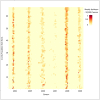Local variations in spatial synchrony of influenza epidemics
- PMID: 22916274
- PMCID: PMC3420894
- DOI: 10.1371/journal.pone.0043528
Local variations in spatial synchrony of influenza epidemics
Abstract
Background: Understanding the mechanism of influenza spread across multiple geographic scales is not complete. While the mechanism of dissemination across regions and states of the United States has been described, understanding the determinants of dissemination between counties has not been elucidated. The paucity of high resolution spatial-temporal influenza incidence data to evaluate disease structure is often not available.
Methodology and findings: We report on the underlying relationship between the spread of influenza and human movement between counties of one state. Significant synchrony in the timing of epidemics exists across the entire state and decay with distance (regional correlation=62%). Synchrony as a function of population size display evidence of hierarchical spread with more synchronized epidemics occurring among the most populated counties. A gravity model describing movement between two populations is a stronger predictor of influenza spread than adult movement to and from workplaces suggesting that non-routine and leisure travel drive local epidemics.
Conclusions: These findings highlight the complex nature of influenza spread across multiple geographic scales.
Conflict of interest statement
Figures






References
-
- Grenfell BT, Bjornstad ON, Kappey J (2001) Travelling waves and spatial hierarchies in measles epidemics. Nature 414: 716–723. - PubMed
-
- Cummings DA, Irizarry RA, Huang NE, Endy TP, Nisalak A, et al. (2004) Travelling waves in the occurrence of dengue haemorrhagic fever in Thailand. Nature 427: 344–347. - PubMed
-
- Grenfell BT, Bolker BM (1998) Cities and villages: infection hierarchies in a measles metapopulation. Ecology Letters 1: 63–70.
-
- Alonso WJ, Viboud C, Simonsen L, Hirano EW, Daufenbach LZ, et al. (2007) Seasonality of Influenza in Brazil: A Traveling Wave from the Amazon to the Subtropics. American Journal of Epidemiology 165: 1434–1442. - PubMed
Publication types
MeSH terms
Grants and funding
LinkOut - more resources
Full Text Sources
Medical

